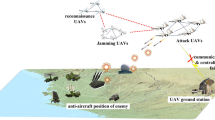Abstract
Unmanned systems can be abstracted as dynamic and complex systems of multi-agent competition and cooperation. Its quantitative and qualitative characteristics are naturally similar to those in network science. Therefore, we can explore how to form a dynamic and efficient adjustment of the link relationship between nodes, based on studying of structural complexity, node complexity, and interactions between structure and nodes in network science. The aforementioned outputs can accordingly support the efficiency of information interaction and dissemination between nodes. To solve the problem of information cooperation in weak communication connection of unmanned systems, this paper proposed an information centrality evaluation method based on the degree of cascaded topology correlation (CTRICE, Cascade Topological Relevance Information Centrality Evaluation). The evaluation method and strategy of cascading topology association degree based on local neighborhood were formed through the evaluation of cascading information aggregation ability within the neighborhood and the evaluation of intimacy based on topology and interaction behavior. Consequently, the results of the assessment would provide support for information fusion and decision-making. This paper first proves the feasibility of this method in terms of information synergy consistency. Meanwhile, it compares and analyzes the convergence efficiency through simulation experiments between the proposed method with assessment methods of mean value and degree centrality. Compared with the traditional method, the proposed method has better robustness and robustness under the condition of low quality communication connections. The method presented in this paper provides an idea for the realization of information self-organization and collaboration based on topological relations in unmanned systems.
Access this chapter
Tax calculation will be finalised at checkout
Purchases are for personal use only
Similar content being viewed by others
References
Jennings, N.R., Sycara, K., Wooldridge, M.: A roadmap of agent research and development. Auton. Agent. Multi-Agent Syst. 1(1), 7–38 (1998)
Krnc, M., Škrekovski, R.: Group degree centrality and centralization in networks. Mathematics 8(10), 1810 (2020). https://doi.org/10.3390/math8101810
Samad, A., Qadir, M., Nawaz, I., et al.: SAM centrality: a hop-based centrality measure for ranking users in social network. Indust. Netw. Intell. Syst. 7, 163985 (2020)
Li, G., Li, M., Wang, J., et al.: United neighborhood closeness centrality and orthology for predicting essential proteins. IEEE/ACM Trans. Comput. Biol. Bioinform. 1–1 (2018)
Shao, Z., Guo, N., Gu, Y., Wang, Z., Li, F., Yu, G.: Efficient closeness centrality computation for dynamic graphs. In: Nah, Y., Cui, B., Lee, S.-W., Yu, J.X., Moon, Y.-S., Whang, S.E. (eds.) DASFAA 2020. LNCS, vol. 12113, pp. 534–550. Springer, Cham (2020). https://doi.org/10.1007/978-3-030-59416-9_32
Bagheri, A.E.: An Influence maximization algorithm in social network using K-shell decomposition and community detection (2020)
Agryzcov, T., Tortosa, L., Vicent, J.F., et al.: A centrality measure for urban networks based on the eigenvector centrality concept. Environ. Plan. B: Urban Anal. City Sci. 46(4), 239980831772444 (2017)
Das, K., Samanta, S., Pal, M.: Study on centrality measures in social networks: a survey. Soc. Netw. Anal. Min. 8(1), 1–11 (2018). https://doi.org/10.1007/s13278-018-0493-2
Klein, D.J.: Centrality measure in graphs. J. Math. Chem. 47(4), 1209–1223 (2010)
Wan, Z., Mahajan, Y., Kang, B.W., et al.: A Survey on Centrality Metrics and Their Implications in Network Resilience. (2020)
Walsh, T.: Algorithms and Experiments for Betweeness Centrality in Tree-Like Networks Bachelorarbeit (2017)
Lu, Z., Fan, L., Wu, W., Thuraisingham, B., Yang, K.: Efficient influence spread estimation for influence maximization under the linear threshold model. Comput. Soc. Netw. 1(1), 1–19 (2014). https://doi.org/10.1186/s40649-014-0002-3
Goyal, A., Lu, W., Lakshmanan, L.V.S.: SIMPATH: an efficient algorithm for influence maximization under the linear threshold model. In: The 2011 IEEE International Conference on Data Mining, pp. 211–220 Vancouver, Canada (2011)
Vicsek, T., Czirok, A., Ben-Jacob, E., et al.: Novel type of phase transition in a system of self-driven particles (2006)
Duan, H.B., Qiu, X.H.: Unmanned Aerial Vehicle Swarm Autonomous Control Based on Swarm Intelligence. China Science Publishing & Media Ltd, Beijing (2018)
Freeman, L.C.: A set of measures of centrality based on betweenness. Sociometry 40(1):35–41 (1977)
Kitsak, M., Gallos, L.K., Havlin, S., et al.: Identifying influential spreaders in complex networks. Nat. Phys. 6(11), 888–893 (2010)
Park, M.J., Lee, S.H., Kwon, O.M.: An eigenvector-centrality based consensus protocol design for discrete-time multi-agent systems with communication delays. In: Park, J.H. (ed.) Recent Advances in Control Problems of Dynamical Systems and Networks. SSDC, vol. 301, pp. 61–81. Springer, Cham (2021). https://doi.org/10.1007/978-3-030-49123-9_3
Myeong-Jin, P., et al.: Weighted consensus protocols design based on network centrality for multi-agent systems with sampled-data. IEEE Trans. Autom. Control 62, 2916–2922 (2017)
Xie, B., Lu, X.: A distributed algorithm based on local centrality for dynamic social network re-construction in multi-agent systems. In: 2020 4th CAA International Conference on Vehicular Control and Intelligence (CVCI), pp. 481–486 (2020)
Julian, Z., et al.: Social adaptation in multi-agent model of linguistic categorization is affected by network information flow. PLoS ONE 12 (2017)
Ma, Y.-Y., Han, H., Qu, Q.-Q.: Importance evaluation algorithm based on node intimate degree. Comput. Sci. 48(5), 140–146 (2021)
Tian, Y.P., Li, Y., Wang, X.Q., et al.: Suppress the diffusion of rumors with nodes closeness mining. Chin. J. Netw. Inf. Secur. (2016)
Author information
Authors and Affiliations
Corresponding author
Editor information
Editors and Affiliations
Rights and permissions
Copyright information
© 2022 Springer Nature Singapore Pte Ltd.
About this paper
Cite this paper
Shen, Y., Wang, K., Gao, Y., Chen, L., Du, C. (2022). Information Centrality Evaluation Method Based on Cascade Topological Relevance. In: Sun, Y., et al. Computer Supported Cooperative Work and Social Computing. ChineseCSCW 2021. Communications in Computer and Information Science, vol 1491. Springer, Singapore. https://doi.org/10.1007/978-981-19-4546-5_19
Download citation
DOI: https://doi.org/10.1007/978-981-19-4546-5_19
Published:
Publisher Name: Springer, Singapore
Print ISBN: 978-981-19-4545-8
Online ISBN: 978-981-19-4546-5
eBook Packages: Computer ScienceComputer Science (R0)





